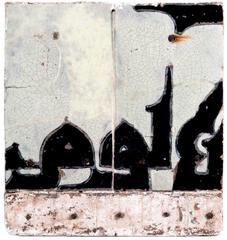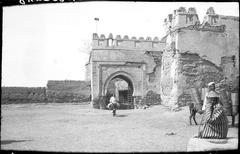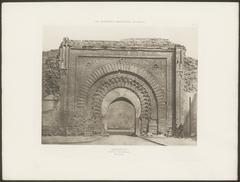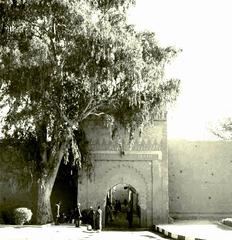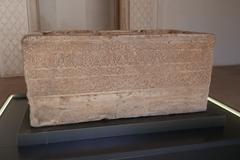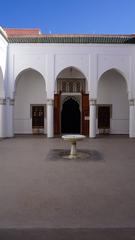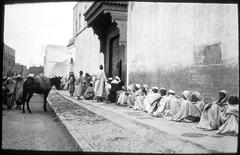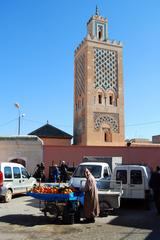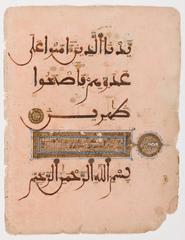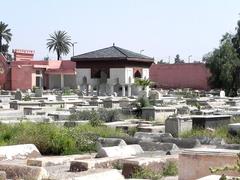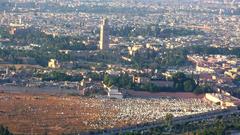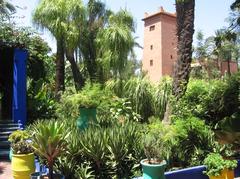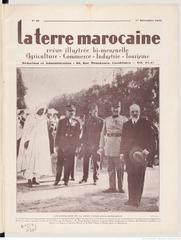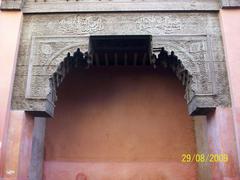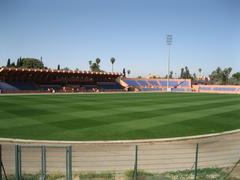Aïn Kassimou Marrakesh, Morocco: Visiting Hours, Tickets, and Complete Guide to a Hidden Historical Estate
Date: 04/07/2025
Introduction: The Allure of Aïn Kassimou
Set in the tranquil Palmeraie district of Marrakesh, Aïn Kassimou stands as a testament to Morocco’s rich heritage, blending traditional artistry, lush landscapes, and a legacy of international influence. Once the private domain of aristocrats and tastemakers such as Patrick Guerrand-Hermès and Marella Agnelli, the estate is renowned for its sophisticated architecture, vibrant gardens, and pivotal role in the city’s equestrian and cultural life. Though public access is limited, Aïn Kassimou remains one of Marrakesh’s most coveted and evocative destinations, offering a rare glimpse into a world where Moroccan tradition meets cosmopolitan luxury.
This guide provides everything you need to know about visiting Aïn Kassimou: historical context, practical visitor information, ticketing, accessibility, and travel tips. For official updates and event schedules, consult the Palmeraie Polo Club, Morocco Tourism Board, Rough Guides, and Tourist Secrets.
History and Cultural Significance
From Private Oasis to Cultural Beacon
Aïn Kassimou’s origins date to the early 20th century, when it began as a private villa amidst the iconic palm groves of the Palmeraie. The estate’s name, derived from the Arabic for “spring” or “source,” reflects its oasis-like ambiance—a haven of greenery and tranquility just beyond the bustling Marrakesh medina.
The property rose to international prominence in the 1980s under Patrick Guerrand-Hermès, who reimagined it as both a lavish private residence and a hub for Moroccan arts and equestrian pursuits. Later, Marella Agnelli’s transformative restoration brought in visionaries like architect Gae Aulenti, designer Alberto Pinto, and landscape architect Madison Cox, ensuring that Aïn Kassimou became a benchmark for Moroccan-European style and cultural sophistication (Catherine M. Austin).
Architectural and Artistic Marvel
Aïn Kassimou’s architecture is a harmonious fusion of Moroccan craftsmanship and European elegance. Key features include:
- Traditional zellige tilework and carved cedar wood.
- Stucco plasterwork by local artisans.
- Expansive gardens irrigated by ancient systems.
- Interiors curated with oriental art, antiques, and equestrian memorabilia.
The estate’s design draws inspiration from both Moroccan riads—with their inward-facing layouts and lush courtyards—and European landscape principles, resulting in a uniquely immersive atmosphere (World History Journal).
Equestrian Heritage and Polo
Guerrand-Hermès established the Palmeraie Polo Club on the estate grounds, transforming Aïn Kassimou into a center for international polo tournaments and equestrian culture. The club’s facilities set a high standard for sport and hospitality, contributing to Morocco’s growing reputation on the global polo stage (Palmeraie Polo Club).
Philanthropy and Cultural Exchange
Aïn Kassimou has long served as a venue for cultural festivals, charity galas, and artistic events, supporting local communities and heritage preservation. Its legacy is not only one of luxury, but of enduring social and artistic impact.
Visitor Information: Hours, Tickets, and Access
Visiting Hours
Aïn Kassimou is a private estate with no regular public opening hours. Access is typically possible only during:
- Special cultural events and festivals.
- Polo tournaments hosted by the Palmeraie Polo Club.
- Private invitations or exclusive luxury tours.
Check event calendars and official websites for up-to-date opportunities to visit.
Tickets and Booking
There is no on-site or online public ticket office. Access is arranged through:
- Official invitations.
- Participation in events (tickets sometimes available via Palmeraie Polo Club or event partners).
- Specialized luxury travel agencies offering private tours.
Advance arrangement is essential; always confirm details and permissions before arrival (Rough Guides).
Guided Tours and Accessibility
Guided tours are rare but may be available through high-end travel operators. Due to the estate’s historic layout, some areas may have limited accessibility for those with mobility needs—confirm in advance if accommodations are required.
What to Expect When Visiting
The Aïn Kassimou Experience
Visitors fortunate enough to access Aïn Kassimou are treated to:
- Lush gardens designed by Madison Cox, with olive groves, citrus trees, and tranquil water features.
- Main house interiors blending Moroccan motifs and European design.
- Pool pavilion and outdoor terraces with Atlas Mountain views.
- Collections of art, antiques, and equestrian memorabilia.
The ambiance is serene, luxurious, and deeply rooted in Marrakesh’s tradition of hospitality and artistry.
Practical Tips
- Dress modestly: Shoulders and knees covered; light fabrics for summer (Lonely Planet).
- Photography: Seek permission before taking photos indoors or of people.
- Best time to visit: Spring and autumn for mild weather and blooming gardens.
- Transport: Private taxi or pre-arranged transfer is best; the Palmeraie is about 15 minutes from the city center.
Etiquette and Cultural Considerations
- Respect privacy and remain within designated visitor areas.
- Tipping guides and staff is customary (10–15% for guides, 10–20 MAD per service for staff).
- Learn basic Arabic or French greetings (“Salam Alaikum,” “Shukran”).
Nearby Attractions
- Jardin Majorelle: Iconic garden and museum (Tourist Places Guide).
- Marrakesh Medina: Historic center with souks and palaces.
- Atlas Mountains: Day trips for hiking and Berber culture (Rough Guides).
Safety, Comfort, and Practical Advice
- July is extremely hot—visit early or late, hydrate frequently, and use sun protection (I Love Marrakech).
- Carry cash; ATMs are scarce in the Palmeraie (Head to Morocco).
- Use official taxis and confirm fares in advance (Bewildered in Morocco).
- In emergencies, dial 19 for police and 15 for ambulance.
Frequently Asked Questions (FAQs)
Q: Can I buy tickets at Aïn Kassimou?
A: No, advance booking is required through official channels or event organizers.
Q: What are the estate’s public hours?
A: There are no regular public hours; access is only by appointment or event.
Q: Is the estate wheelchair accessible?
A: Some areas may be challenging; inquire before booking.
Q: Is photography allowed?
A: Outdoor photography is generally permitted; always seek permission indoors.
Q: What language is spoken?
A: Arabic and French are dominant; English is widely understood in tourism.
Visual Gallery
Alt text suggestions: “Aïn Kassimou visiting hours,” “Marrakesh historical sites,” “Aïn Kassimou tickets.”
Plan Your Visit and Stay Connected
- For updates and event schedules, visit the Palmeraie Polo Club and Morocco Tourism Board.
- Download the Audiala app for real-time updates, exclusive tours, and more insider tips.
Summary: Why Visit Aïn Kassimou?
Aïn Kassimou is a jewel of Marrakesh’s Palmeraie—a sanctuary of art, history, and natural beauty shaped by a legacy of international stewardship and Moroccan tradition. While access is exclusive, the estate offers a rare opportunity to experience the city’s evolving identity, from its lush gardens and architectural marvels to its vibrant cultural events. Careful planning, respect for privacy, and a sense of adventure will ensure a memorable and rewarding visit.
For the latest information, consult Palmeraie Polo Club, Morocco Tourism Board, and download the Audiala app for exclusive access and updates. Embrace the hidden magic of Marrakesh and discover why Aïn Kassimou remains one of its most fascinating and inspiring destinations (Catherine M. Austin; World History Journal; Tourist Secrets).
References and Further Reading
- Palmeraie Polo Club
- World History Journal
- Catherine M. Austin
- Head to Morocco
- Tourist Secrets
- Rough Guides
- Marrakech Guided Experience
- Tourist Places Guide
- I Love Marrakech
- Bewildered in Morocco
- The Crazy Tourist
- Infinite Morocco
- Global Highlights
- The Broke Backpacker
